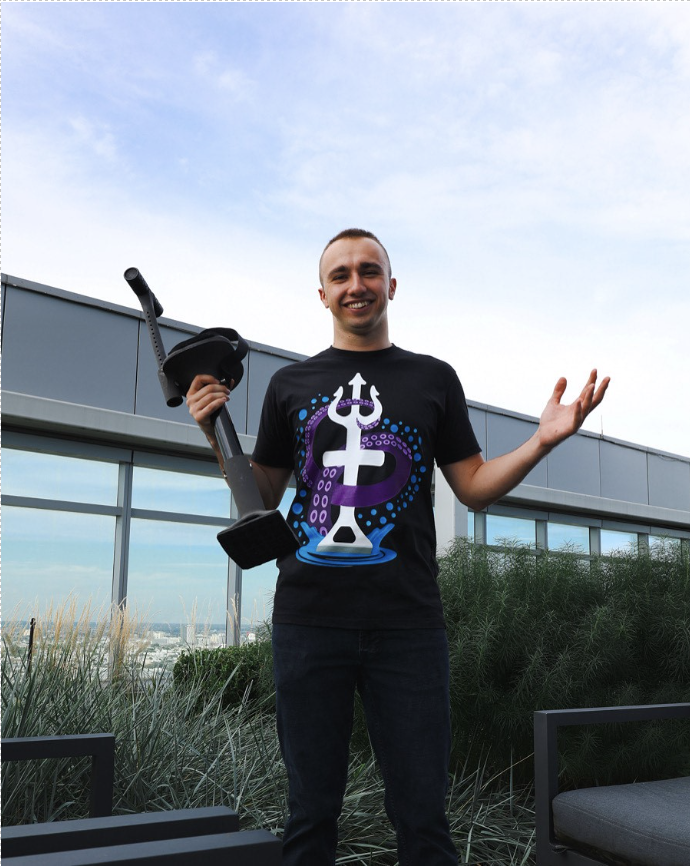Inspired by his battle with Lyme Disease, James Calcagni, ENG ’22, wanted to use his engineering background to help people who suffer from medical conditions.
“I wanted to figure out how to create a solution to a medical problem, that will help a niche group of people,” says Calcagni.
For his senior design project, as part of the College of Engineering’s senior capstone, he wanted to create a prosthetic device for people with leg amputations that can be used where current prosthetics cannot.
To understand the problem, and identify a solution, Calcagni interviewed people with mobility assistance devices to see how he could use his skills to help them. Through in-depth interviews, he found that one of the biggest issues for people with prosthetic limbs is that they can’t be used in the shower. From this, he began to develop the idea for his device called the Navigator.
He used his prototype as part of his senior design project and took home first place in the fall 2021 Senior Design Competition, sponsored by the Temple University College of Engineering. After a few tweaks to his executive summary and a quick competitor analysis, he was ready to take the Navigator to the annual Changemaker Challenge, a social impact competition sponsored by the Innovation & Entrepreneurship Institute (IEI). The Navigator would become the first product of his new venture Liquid Limbs.
The Changemaker Challenge empowers social entrepreneurs to create ventures that focus on making a lasting social impact. The Challenge provides non-diluted seed funding, entrepreneurial resources, and mentoring opportunities to students, alumni, faculty and staff from all 17 schools and colleges across Temple University.
Liquid Limbs went on to win first place in the undergraduate track of the 5th annual Changemaker Challenge. The win gave Calcagni the confidence boost he needed to double down on his prototype, work on a formal business plan plus investor pitch, and submit to the 24th annual Be Your Own Boss Bowl® (BYOBB®).
“Working on a business plan at the IEI to turn it into an investable venture helped to make me a better engineer. I wasn’t just focusing on the solution, but I was evaluating the problem and looking at solutions from all angles,” says Calcagni.
To prepare for the BYOBB®, Calcagni took advantage of the suite of resources available to all budding Owlpreneurs, such as mentoring sessions with dedicated and seasoned experts, workshop sessions over Zoom to meet entrepreneurs where they are and the wealth of knowledge from IEI faculty and staff.
“I am grateful for the mentorship opportunities that were available at the IEI. Working with those experts, it really helped me to think more like a business owner than simply an engineer with a prototype. I learned a lot of skills and business knowledge for what it takes to be an entrepreneur,” says Calcagni.
The annual Be Your Own Boss Bowl®(BYOBB), now going into its 25th year, is another competition sponsored by the IEI, and in addition to workshops and mentoring, has a total cash and in-kind prize package worth over $200,000. In this past April’s BYOBB® competition, Calcagni and Liquid Limbs won second place in the undergraduate track.
For future competitors, Calcagni stresses the importance of three things: a good foundation, a strong team, and practice, practice, practice of your pitch. Turning an idea into a product requires lots of learning, but having the support of a strong team, and support from mentors, helped Calcagni alleviate the stress of practicing his pitch.
“Every challenge I’m faced with, I try to take as a learning lesson. There’s been a lot of lessons learned during my entrepreneurial journey,” says Calcagni.
Now that he has his patents filed, he is focusing on completing another round of prototypes to prepare for the formal launch of his venture.
So, what’s the ultimate goal for James Calcagni and his Navigator?
“I want to change how we think about and approach prosthetics, and do what I can to make those needing mobility aids easier or more comfortable, but truly more accessible.”
